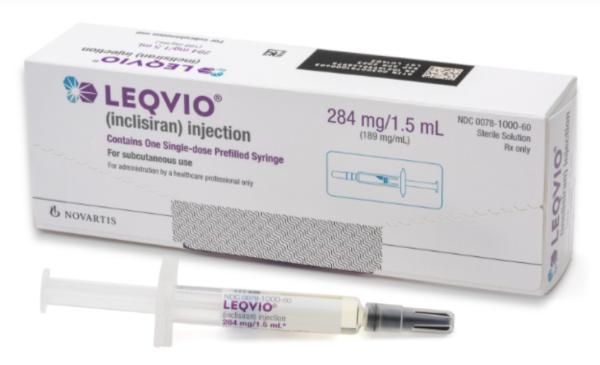Leqvio Dosage
Generic name: INCLISIRAN SODIUM 284mg in 1.5mL
Dosage form: injection, solution
Drug class: Miscellaneous antihyperlipidemic agents
Medically reviewed by Drugs.com. Last updated on Jul 31, 2025.
2.1 Recommended Dosage
- The recommended dosage of LEQVIO is 284 mg administered as a single subcutaneous injection initially, again at 3 months, and then every 6 months.
- If a planned dose is missed by less than 3 months, administer LEQVIO and maintain dosing according to the patient’s original schedule.
- If a planned dose is missed by more than 3 months, restart with a new dosing schedule - administer LEQVIO initially, again at 3 months, and then every 6 months.
- Assess LDL-C when clinically indicated. The LDL-lowering effect of LEQVIO may be measured as early as 30 days after initiation and anytime thereafter without regard to timing of the dose.
2.2 Important Administration Instructions
- LEQVIO should be administered by a healthcare professional.
- Inject LEQVIO subcutaneously into the abdomen, upper arm, or thigh. Do not inject in areas of active skin disease or injury, such as sunburns, skin rashes, inflammation, or skin infections.
- Inspect LEQVIO visually before use. It should appear clear and colorless to pale yellow. Do not use if particulate matter or discoloration is seen.
For more detailed instruction on administration of the prefilled syringe, see Instructions for Use.
Frequently asked questions
- What is the difference between Leqvio and Repatha?
- What are PCSK9 Inhibitors and how do they work?
- Can Leqvio be taken without a statin?
- Does Leqvio cause weight gain?
- How is Leqvio injection administered?
- What is the mechanism of action for Leqvio (inclisiran)?
- Is Leqvio FDA approved as a high cholesterol treatment?
- Where can I find the Leqvio FDA package insert?
- How does Leqvio work in treating high cholesterol?
More about Leqvio (inclisiran)
- Compare alternatives
- Pricing & coupons
- Reviews (99)
- Drug images
- Side effects
- During pregnancy
- Support group
- FDA approval history
- Drug class: miscellaneous antihyperlipidemic agents
- Breastfeeding
- En español
Patient resources
Professional resources
Related treatment guides
See also:
Further information
Always consult your healthcare provider to ensure the information displayed on this page applies to your personal circumstances.


